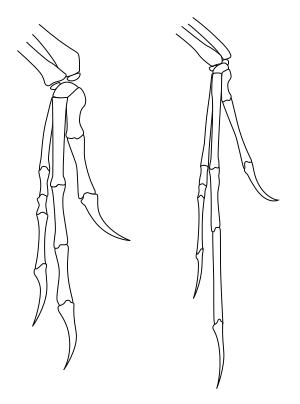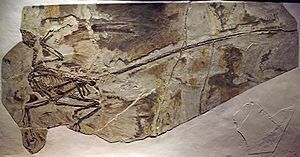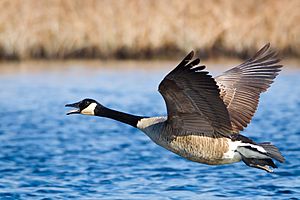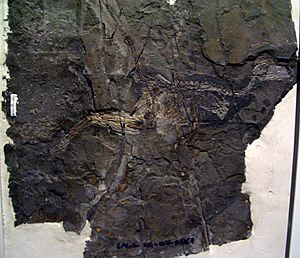Maniraptor facts for kids
Quick facts for kids ManiraptoraTemporal range: Jurassic – Recent
|
|
|---|---|
 |
|
| The hands of Deinonychus (left) and Archaeopteryx (right) are typical of maniraptorans. | |
| Scientific classification | |
| Kingdom: | |
| Phylum: | |
| Class: | |
| Order: | |
| Suborder: | |
| (unranked): | |
| Family: |
Maniraptora
Gauthier, 1986
|
Maniraptors are a group of dinosaurs whose name means "hand snatchers." They are part of a larger group called coelurosaurian dinosaurs. These amazing creatures first appeared during the Jurassic period.
Many scientists who study fossils, called paleontologists, believe that birds today actually evolved from maniraptors. This means that birds are a type of maniraptor, and other maniraptors are their closest ancient relatives. We now know that many, or even all, maniraptors had feathers. Because of this, they are often called "dinobirds."
The earliest or most basic member of this group might be Ornitholestes. One of the most advanced non-bird maniraptors was Deinonychus.
Contents
What Makes Maniraptors Special?

Maniraptors have several unique features. They usually have long arms and hands with three fingers. Some types might have had fewer or fused fingers. They also have a special "half-moon shaped" bone in their wrist.
Maniraptors are the only dinosaurs known to have strong, bony breast bones. Scientists have also found six other specific bone features that are unique to maniraptors.
Most other saurischian dinosaurs had hip bones that pointed forward. However, several maniraptor groups had hip bones that pointed backward, similar to ornithischian dinosaurs. This backward-pointing hip is seen in therizinosaurs, dromaeosaurids, avialans (which include birds), and some early troodontids.
Scientists believe that the backward-pointing hip was an early feature for maniraptors. Some later groups, like advanced troodontids and oviraptorosaurs, seem to have gone back to having forward-pointing hips.
Did Maniraptors Have Feathers and Could They Fly?

Modern bird feathers, like the large flight feathers on wings, are found in a group of advanced maniraptors called Aviremigia. Older maniraptors, such as Beipiaosaurus, had a mix of simple, downy feathers and longer, quill-like feathers.
Simple feathers have been found on even older dinosaurs like Sinosauropteryx prima. Some scientists even think that other ancient creatures, like the plant-eating dinosaur Tianyulong confuciusi and flying pterosaurs, might have had some form of feathers or fuzzy skin. This suggests that all maniraptors likely had feathers, especially when they were young.
Maniraptora is the only group of dinosaurs known to include members that could fly. However, scientists are still debating how far back in their family tree this ability goes. Some dromaeosaurids, like Rahonavis and Microraptor, are thought to have been able to glide or even fly.
Zhenyuanlong suni, another dromaeosaurid, was too heavy to fly. But it still had wings with feathers, which suggests its ancestors could fly. This means that some flying abilities might have been lost over time.
Other groups, like the Oviraptorosauria, are not known to have flown. However, some scientists think they might have come from ancestors that could fly.
What Did Maniraptors Eat?
For a long time, scientists thought that most non-bird maniraptors were hypercarnivorous. This means they mainly hunted and ate other animals.
However, new discoveries and a fresh look at old evidence in the 2000s changed this idea. It now seems that maniraptors were mostly omnivorous, meaning they ate both plants and animals. Many subgroups specialized in eating plants, insects, or other foods besides just meat.
Studies of maniraptor family trees showed that plant-eating or omnivorous groups were common throughout the Maniraptora. This led scientists to believe that the earliest maniraptor was likely an omnivore. From this omnivorous ancestor, some groups became purely plant-eaters, like the therizinosaurs and some early oviraptorosaurs and birds.
Among the non-bird maniraptors, only one group, the dromaeosaurids, seems to have gone back to being pure meat-eaters. Most other groups ate a mix of foods. For example, alvarezsaurids and some birds ate insects, while advanced oviraptorosaurs and troodontids were omnivores.
See also
 In Spanish: Maniraptora para niños
In Spanish: Maniraptora para niños


